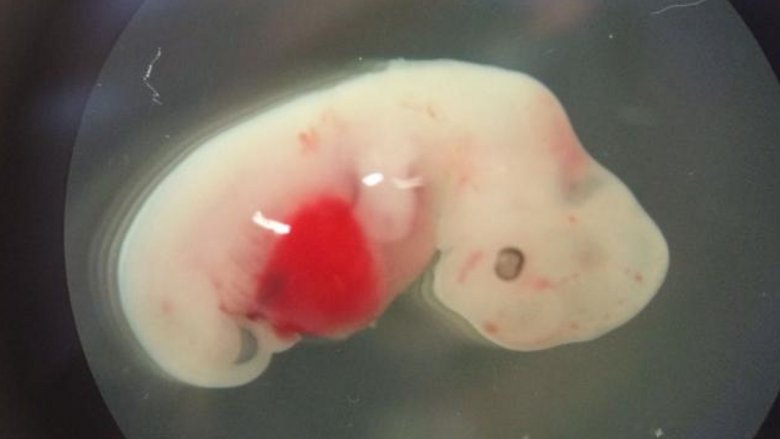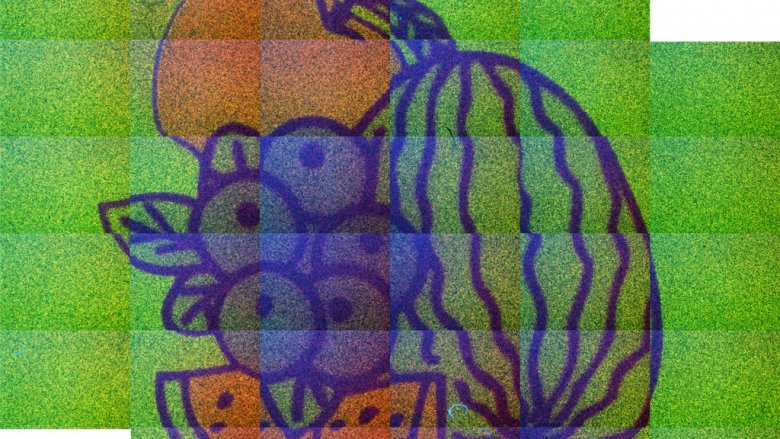Amazing Inventions That Could Change The World
Arthur C. Clarke famously claimed that "any sufficiently advanced technology is indistinguishable from magic." That would certainly explain why babies instantly poop their diapers the first time they see Peekaboo. Their tiny infant brains go gaga for hand-over-face technology. As babies age, however, they need increasingly impressive Peekaboo equivalents to get that same excited feeling. Thankfully, science is up to the challenge, inventing neat and novel ways to improve the world while keeping our Huggies fully loaded. Here are inventions that could change the world.
Tangible 3-D holograms
Prior to 2015, the greatest thing about holograms was that time Tupac Shakur got digitally resurrected for a Coachella concert. And sadly, that wasn't even a real hologram, just a fancy CGI reflection that everyone misnamed. That's at least eight flavors of uncool. Presumably, Japanese scientists witnessed this massive letdown and took it as a call to action. Why else would they have busted out with haptic 3-D holograms?
As detailed by Gizmodo, high-tech sorcerers at the University of Tokyo and the Nagoya Institute of Technology joined forces to make plasma holograms that you can touch. If you ignore all the complex physics behind it, their method sounds pretty simple. Image experts used an incomprehensibly fast light beam called a femtosecond laser (obviously) to get matter super-duper energized. This produced a series of bright dots called "voxels" that can be arranged in all sorts of 3-D formations. Play the YouTube clip above and you'll see a heart, a star, and possibly other Lucky Charms shapes.
Besides being way swankier than Coachella Tupac, these real holograms -– which creators adorably called Fairy Lights –- pull off an unreal party trick. When you try to touch one, the plasma voxels emit a pulse you can sense. Head researcher Yoichi Ochiai likened it touching sandpaper, according to Popular Science. In short, don't rub your face against them. Clearly, the technology's bursting with potential. If producible on a large scale, it could reinvent games, movies, and telecommunications, not to mention the sex industry.
Bulletproof gel
It doesn't take a gun scientist to prove bullets and bodies don't get along. Militaries, therefore, have a vested interest in keeping soldiers' innards bullet-free. Unfortunately, that takes a high caliber of protection that standard approaches can't always attain. Ceramic body armor, for example, breaks bullets on impact. But as per the BBC, its rigidity limits how much body it can armor. A Kevlar-carbon combo might suffice, but according to the Air Force Times, the materials become shatter-prone when joined by traditional adhesives.
The ideal, of course, would be a flexible, shatterproof material that prevents soldiers from becoming Swiss cheese. One option is D3O gel. That sounds like a Star Wars-themed hair product, but in 2009 the UK's Ministry of Defense deemed it a bona fide bullet buffer. The Telegraph reported that the invention remains pliable at rest and instantly solidifies when struck, providing a cushiony alternative to awkward, bulky armor. It's presumably also fun to squeeze; it looks like Silly Putty. Given those benefits, the military invested £100,000 into developing D3O further.
In 2014, the U.S. Air Force Academy took the notion of goopy gut-protectors to the next level. According to the Air Force Times, the school gave cadets Kevlar, carbon, and an epoxy and basically told them to do something useful with it. By 2017, Cadet Hayley Weir and her professor had engineered a potent trifecta of Kevlar, carbon, and gooey stuff that could withstand .44 Magnum rounds. That's got to be worth at least a B+.
See-through wood
If Rock Paper Scissors taught us anything, it's that metal beats wood products. If you doubt that, just have an oak tree fight a chainsaw and see what happens. Students at the University of Maryland, however, decided to turn the tables by giving our arboreal friends a chemical advantage. Relying on scientific wizardry and maybe a dash of alchemy, they produced transparent wood that could feasibly surpass steel in hardness.
As per CNN, students achieved the botanical oddity by stripping wood of its lignin, which is the stuff that gives wood its jaundiced complexion. They then injected the plant fibers with an epoxy to add strength and durability. Presto change-o, nature's rearranged, yo. No longer just the stuff of paper and matches, this chromatically naked wood can match glass in clarity and best metal in toughness, given the right amount of epoxy. The foreseeable benefits are manifold.
As a natural insulator, see-through wood would make an excellent window compared to glass, which suffers heat incontinence in the winter and leaks cold air in the summer. Moreover, whereas metal has to be mined, you can just grow trees. Done sustainably, this could give the environment a much-needed boost. Best of all, you could live in a clear wood house and throw all the stones you want. Mankind could finally reach its hypocritical apex, and Rock Paper Scissors would be forever changed.
Spray-on skin
Being on fire isn't fun. It hurts horribly and often leaves people with lost skin and significant scarring. Pennsylvania state trooper Matt Uram certainly knows a thing or two about that. According to Newsweek, in 2009 Uram suffered severe burns after a Fourth of July bonfire gave him an unexpected and extremely unwanted hug. Luckily, the Mercy Burn Center in Pittsburgh had been dabbling in a newfangled burn treatment: spray-on skin.
Developed by Dr. Jorg Gerlach, the technology relies on stem cells extracted from a tiny patch of healthy skin and suspended in liquid. From there, the cells get spritzed onto an area of damaged skin like cologne. Doctors applied this approach to the nearly third-degree burns on Uram's right arm. A few days later, he had brand new, unblemished skin. It was like cooking a bratwurst in reverse. All he needed to rejuvenate his arm was a postage-stamp-sized clump of flesh.
That certainly beats the go-to method of skin replacement. Presently, grafts are where it's at, and they're pretty unpleasant. Grafting requires surgeons to remove a large swath of undamaged skin, attach it to an injured site, and hope the patient's body doesn't reject it. That's literally harming one part of the body to heal another. Uram didn't face that ugly tradeoff. Neither did the dozens of experimental patients who followed. If FDA clinical trials (planned for 2017) go well, perhaps burn victims won't have to get peeled like apples as part of their treatment.
3-D-printed buildings
Industrious individuals have applied 3-D printing to a vast array of items, including prosthetic limbs, commercial chocolate, and perhaps chocolate appendages down the line. But even the promise of human-dessert hybrids doesn't capture the full size and scope of what the technology can do. For instance, one day you could find yourself chewing on your Hershey's forearm while chilling in a 3-D-printed house.
In 2017, MIT researchers announced that they had used a rolling robotic arm to print a gigantic foam dome in less than 14 hours. At 12 feet high and 50 feet in diameter, the roofless structure could fit a fair number of grown-ups or a ton of fat babies. What's more, the printer can adjust to the thickness of various construction materials and tackle any size of building. In theory, you could print a massive gingerbread house like the one in Hansel and Gretel.
But even if you don't dig stories about child-eating, a house-printing robot still has lots of value. As the Los Angeles Times pointed out, construction companies could save loads of time and money by printing a building's building blocks onsite rather than having to order them from elsewhere. The device would also come in handy in disaster-ravaged locales. A person whose home has been turned to toothpicks could have a makeshift shelter in no time. It could even help victims of house fires who have nowhere to stay. In short, humanity shouldn't limit itself to printing chocolate limbs.
Disease-detecting breathalyzers
Breathalyzers provide convincing chemical evidence against even the soberest of drunk drivers. But soon these mechanical drug dogs may be joined by a breed of more medically inclined breath-sniffers. In December 2016, the journal ACS NANO published results from a study in which a new type of breathalyzer helped experts to pick out over a dozen different maladies, including ovarian cancer and kidney disease. (No word yet on halitosis.)
As per LiveScience, the device contains carbon and gold nanoparticles divided into two separate strata. These layers interact to detect volatile organic compounds (VOCs) contained in human breath. In order to link VOC readings to underlying ailments, researchers need only consult a database of diseases, which all have unique VOC profiles. To test the breathalyzers, investigators recruited 1,400 subjects from various countries. The researchers diagnosed 17 distinct diseases with 86 percent accuracy. Perhaps more remarkably, the breathalyzers only needed 13 of the many hundreds of VOCs to arrive at the right conclusion. (One can only assume the rest serve as oral hygiene indicators.)
The Telegraph observed that these devices could cost as little as £24 in the U.K., saving hospitals oodles of cash on medical tests. Furthermore, they provide a palatable alternative to more intrusive forms of VOC measurement, such as poop analysis. Most interestingly, this breakthrough reaffirms the ancient belief that you can smell illness on a person's breath. In the days before toothpaste, that practice likely caused as much sickness as it detected.
Autonomous robot surgeons
People dread the day when machines render most jobs obsolete and start building terminators for fun. You would only find work doing things robots find demeaning or performing complicated tasks like surgery. Sure, robots assist doctors in hospital settings, but they lack the judgment and care it takes to mutilate a body back to health. For that you need a human's nuanced touch. At least for now, but that could soon change.
In 2016, Popular Mechanics reported that the Smart Tissue Autonomous Robot -– called STAR for short -– successfully operated on sedated pigs all by its lonesome. Consisting of a huge hydraulic arm, an eye with near-infrared vision, and probably wires or something, STAR relies on complex algorithms and instructions to identify damaged organ meat and operate on it accordingly. In this particular instance, it sutured together pig intestines. Granted, humans assisted with minor tasks like keeping the suture thread untangled, but you could probably train a smart monkey or several limber pigeons to do that.
STAR not only did a bang-up job sewing swine, but it outperformed all its competition. Neither humans nor robot-assisted humans could match the machine in consistency or precision, arguably making STAR the best pig bowel surgeon on Earth. And that's just the beginning. Biochemist Peter Kim, who helped create STAR, believes that robots like it may one day replace humans in soft-tissue procedures like tumor removal. That's either really rad or terrifying –- likely the latter if you're a surgeon.
T-shirt breathing monitors
Imagine the following scenario. You've spent the last decade dating an avid chain smoker, which is like kissing the inside of a chimney for ten years. After a while, your battered lungs get a hankering for emphysema with a side of bronchitis. Worse yet, because these disorders develop slowly, you might not recognize your respiratory decay until you've become a wheezing husk of your former self. Too bad you didn't have a handy-dandy tool to warn you about your failing lung health years ago.
In 2017, the benevolent brains at France's Université Laval came up with a solution: T-shirts that check your breathing in real time. That might evoke images of bulky padding, wires, or hard-to-remove stickers, which would be uncomfortable and tacky, but as Science Daily explained, the T-shirt relies on an optical fiber antenna with a literal silver lining. The fiber measures chest movement and inhalation, so the shirt doesn't have to be tight. Moreover, the antenna has a weather-resistant coating, so you can still walk in the rain without a coat or umbrella. The coolest part: it wirelessly interfaces with your smartphone.
That doesn't mean you should lick cigarette butts until your T-shirt says it's hurting you, but if you suffer from asthma, get exposed to dangerous particulates at work, or just really don't trust your lungs, a wearable breathing monitor has obvious benefits. In addition to warning you about possible respiratory problems, the T-shirt gives you a credible reason to change clothes less often.
Human-pig embryos
The most inconvenient truth Al Gore ever faced was the nonexistence of ManBearPig. But in 2017 scientists at the Salk Institute revealed that they had created two-thirds of the mythical beast (sort of). Neither of those thirds involved a bear, which is a shame because bear plus anything equals amazing. However, splicing humans and ham holds huge ramifications for organ donation.
As noted by National Geographic, 22 people die each day in the U.S. while waiting for an organ transplant. And every 10 minutes a new person joins the list of hopeful organ recipients. The Hippocratic oath probably forbids harvesting random people's organs, so doctors need another option. One they've long entertained is growing human parts in other animals. As a step in that direction, Salk Institute scientists inserted slightly matured human stem cells into pig embryos after successfully tinkering with mouse-rat pairings and not so successfully with rat-pig abominations. (Seriously, no one wants rat pork.) Unlike the rat cells, the human cells survived in the pig embryos, which grew for four weeks before researchers put a stop to it.
To be clear, this mad science project didn't come remotely close to producing swine-grown human hearts, which are feasible but still a long way off. Moreover, mixing species makes people antsy, resulting in research funding roadblocks. Surprisingly, these concerns don't address the most crucial question of all: if pig people (or people-pigs) eventually become a thing, would that make bacon a form of cannibalism?
E. coli artwork
To most people, E. coli is only useful for plaguing foes with cramping and crapping. Otherwise, it's just a crummy old bacterium you shouldn't swallow. The innovative minds at MIT, however, saw much nobler possibilities for these reviled microbes and put them to work making pretty pictures.
According to Gizmodo, in 2005 MIT researchers genetically programmed bacteria to produce black-and-white pictures when exposed to light. That's fine if you like your science bland and colorless, but scientists believed they could take this achievement further by producing color images. As Nature explained, this required more than quadrupling the number of genes inserted into E. coli (18 instead of four). The genes coded for red, blue, and green light receptors, as well as corresponding pigment producers. By flashing colored lights on altered E. coli, scientists produced images of fruit (pictured above), lizards, and even Super Mario bounding over a drainpipe.
The findings were published in 2017, much to the delight of fruit enthusiasts and Mario enthusiasts. Scientists had even greater cause for excitement. Light-sensitive bacteria could potentially produce a diverse range of molecules and proteins, which has all kinds of medical and commercial applications. And just think: if gene manipulation can make light-responsive bacteria, then why not toy with other kinds of stimuli? How awesome would it be if bacteria could detect illnesses (instead of causing them) or respond to dangerous pathogens by secreting medicine? Anti-bacterial soap would seem pretty silly.
Injectable oxygen
It's time to imagine another scenario. You're sitting outside drinking a delightful bubble tea. Suddenly, a beagle gets ejected from a passing car and hits you dead in the chest at breakneck speed. The dog ends up fine, but your lungs are totally wrecked. You keel over, gasping for air as neighbors call for help. Paramedics rush to the scene and give you an oxygen mask. But jinkies, you can't inhale because tea bubbles have completely clogged your windpipe and refuse to dislodge. If only there was another way to administer oxygen quickly.
Cardiologist John Kheir might have a way. In 2012, Boston Children's Hospital announced that Kheir and others devised a method to add oxygen to blood intravenously. The idea itself dates back the 1900s, but back then people used oxygen gas, which not only failed to deliver but could make things worse. Doctors dislike that sort of thing, so Kheir went in a different direction. He and his colleagues discovered that if you encase oxygen in tiny balls of fat, you can inject it into asphyxiating animals without killing them. In fact, they survived 15 minutes without breathing.
Injectable oxygen would be a pretty nifty invention for an emergency situation where air passages are blocked or just too weak to function. According to the University of Michigan website, research was still underway in 2016. If successful, it would create a world where shooting fat into your veins could actually save your life. Technology's magical that way.




